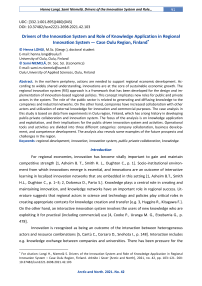Drivers of the innovation system and role of knowledge application in regional innovation system - case Oulu region, Finland
Автор: Longi Henna, Niemel Sami
Журнал: Arctic and North @arctic-and-north
Рубрика: Social and economic development
Статья в выпуске: 42, 2021 года.
Бесплатный доступ
In the northern periphery, actions are needed to support regional economic development. According to widely shared understanding, innovations are at the core of sustainable economic growth. The regional innovation system (RIS) approach is a framework that has been developed for the design and implementation of innovation-based regional policies. This concept implicates new roles for public and private actors in the system. The role of the public sector is related to generating and diffusing knowledge to the companies and industrial networks. On the other hand, companies have increased collaboration with other actors and utilization of external knowledge for innovation and commercial purposes. The case analysis in this study is based on data from experiments in Oulu region, Finland, which has a long history in developing public-private collaboration and innovation system. The focus of the analysis is on knowledge application and exploitation, and their implications for the public driven innovation system and activities. Operational tools and activities are divided into three different categories: company collaboration, business development, and competence development. The analysis also reveals some examples of the future prospects and challenges in the region.
Regional development, innovation, innovation system, public-private collaboration, knowledge
Короткий адрес: https://sciup.org/148318347
IDR: 148318347 | DOI: 10.37482/issn2221-2698.2021.42.103
Список литературы Drivers of the innovation system and role of knowledge application in regional innovation system - case Oulu region, Finland
- Asheim B.T., Isaksen A., Trippl M. Advanced Introduction to Regional Innovation Systems. Edward Elgar Publishing, 2019. 146 p.
- Doloreux D., Parto S. Regional Innovation Systems: Current Discourse and Unresolved Issues. Technology in society, 2005, vol. 27, no. 2, pp. 133-153. DOI: 10.1016/j.techsoc.2005.01.002
- Huggins R., Kitagawa F. Regional Policy and University Knowledge Transfer: Perspectives from Devolved Regions in the UK. Regional Studies, 2012, vol. 46, no. 6, pp. 817-832. DOI: 10.1080/00343404.2011.583913
- Cooke P., Uranga M.G., Etxebarria G. Regional Innovation Systems: Institutional and Organisational Dimensions. Research policy, 1997, vol. 26, no. 4-5, pp. 475-491. DOI: 10.1016/S0048-7333(97)00025-5
- Cantu C., Corsaro D., Snehota I. Roles of Actors in Combining Resources into Complex Solutions. Journal of Business Research, 2012, vol. 65, no. 2, pp. 139-150. DOI: 10.1016/j.jbusres.2011.05.013
- Tether B.S. Who Co-Operates for Innovation, and Why: An Empirical Analysis. Research policy, 2002, vol. 31, no. 6, pp. 947-967. DOI: 10.1016/S0048-7333(01)00172-X
- Ankrah S., Omar A.T. Universities-Industry Collaboration: A Systematic Review. Scandinavian Journal of Management, 2015, vol. 31, no. 3, pp. 387-408. DOI: 10.1016/j.scaman.2015.02.003
- West J., Bogers M. Leveraging External Sources of Innovation: A Review of Research on Open Innovation. Journal of product innovation management, 2014, vol. 31, no. 4, pp. 814-831. DOI: 10.1111/jpim.12125
- Granovetter M. The Impact of Social Structure on Economic Outcomes. Journal of economic perspectives, 2005, vol. 19, no. 1, pp. 33-50.
- Uotila T., Harmaakorpi V., Melkas H. A Method for Assessing Absorptive Capacity of a Regional Innovation System. Fennia-International Journal of Geography, 2006, vol. 184, no. 1, pp. 49-58.
- Lewin A.Y., Massini S., Peeters C. Microfoundations of Internal and External Absorptive Capacity Routines. Organization science, 2011, vol. 22, no. 1, pp. 81-98. DOI: 10.1287/orsc.1100.0525
- Tödtling F., Trippl M. One Size Fits All?: Towards a Differentiated Regional Innovation Policy Approach. Research policy, 2005, vol. 34, no. 8, pp. 1203-1219. DOI: 10.1016/j.respol.2005.01.018
- Schartinger D., Rammer C., Fröhlich J. Knowledge Interactions between Universities and Industry in Austria: Sectoral Patterns and Determinants. Innovation, networks, and knowledge spillovers. Ed. by M.M. Fisher. Springer, Berlin, Heidelberg, 2006, pp. 135-166.
- Cooke P. Global Clustering and Regional Innovation: Systemic Integration in Wales. Regional Innovation Systems. Ed. by H.J. Braczyk, P. Cooke, M. Heidenreich. UCL Press, London, 2004, pp. 245-262.
- Cantù C., Corsaro D., Tunisini A., de Zubielqui G.C., Jones J., Seet P.S., Lindsay N. Knowledge Transfer between Actors in the Innovation System: A Study of Higher Education Institutions (HEIS) and SMES. Journal of Business & Industrial Marketing, 2015, vol. 30, no. 3/4, pp. 436-458. DOI: 10.1108/JBIM-07-2013-0152
- Santoro M.D., Gopalakrishnan S. The Institutionalization of Knowledge Transfer Activities within Industry-University Collaborative Ventures. Journal of engineering and technology management, 2002, vol. 17, no. 3-4, pp. 299-319. DOI: 10.1016/S0923-4748(00)00027-8
- Asheim B.T., Smith H.L., Oughton C. Regional Innovation Systems: Theory, Empirics and Policy. Regional studies, 2011, vol. 45, no. 7, pp. 875-891. DOI: 10.1080/00343404.2011.596701
- Autio E. Evaluation of RTD in Regional Systems of Innovation. European planning studies, 1998, vol. 6, no. 2, pp. 131-140. DOI: 10.1080/09654319808720451
- Sotarauta M. Aluekehittämisen kehityskaari Suomessa ja peruskäsitteet. Governance: Hallinnan uusia ulottuvuuksia. Ed. by I. Karppi I. University of Tampere, Finland, 2015. pp. 215-230.
- Tervo H. Regional Policy Lessons from Finland. Regional disparities in small countries. Ed. by D. Felsenstein, B.A. Portnov. Berlin, Springer-Verlag, 2005, pp. 267-282.
- Porter M.E. The Competitive Advantage of Nations. Harvard business review, 1990, vol. 68, no. 2, pp. 73-93.
- Porter M.E. Competitive Advantage, Agglomeration Economies, and Regional Policy. International Re-gionalScience Review, 1996, vol. 19, no. 1&2, pp. 85-94. DOI: 10.1177/016001769601900208
- Herala J., Simonen J., Svento R. Oulun seutu äkillisen rakennemuutoksen alueena. Kansantaloudellinen aikakauskirja, 2017, vol. 113, pp. 141-168.
- Hintsala H., Niemelä S., Tervonen P. Is there an Arctic Ecosystem Emerging? Oulu Region's Perspective. International Journal of Information Technology and Business Management, 2015, vol. 15, no. 1, pp.21-27.
- Simonen J., Herala J., Svento R. Creative Destruction and Creative Resilience: Restructuring of the Nokia Dominated High-Tech Sector in the Oulu Region. Regional Science Policy & Practice, 2020, pp. 1-23. DOI: 10.1111/rsp3.12267
- Lau A.K., Lo W. Regional Innovation System, Absorptive Capacity and Innovation Performance: an Empirical Study. Technological Forecasting and Social Change, 2015, vol. 92, pp. 99-114. DOI: 10.1016/j.techfore.2014.11.005


